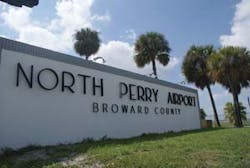PEMBROKE PINES, FL — Comments Nina Demeo, airport manager of nine years at North Perry Airport, “In South Florida, there are not many airports with land left to develop; we are lucky to have land to develop.” Currently working on a $12 million capital improvement plan to develop some 16-acres of that available land is the field’s newest fixed base operator, The Fuel Depot at Bobby’s Landing. With projects in place to add hangar storage, a new terminal building, and a WWII-era themed restaurant, expectations are for continued growth and success at the North Perry Airport, says director of strategic operations for the FBO, Milo Srkal.
North Perry is located just 30 minutes from downtown Miami and sits on 511 acres with four active runways. Manager Demeo describes North Perry as a ‘grassroots’ airport due to the diverse mixture of aircraft activity found here.
“We are very busy with GA traffic,” says Demeo. “The activity includes everything from blimps and banner towing to helicopter operations and flight training.”
A World War II airport with an unmistakable wagonwheel runway configuration(remnants of which can still be seen from an aerial view), North Perry was once owned and operated by the U.S. Navy — and was Perry Dairy Farms before that.
Now funded by the Broward County Aviation Department, there are 311 aircraft based on the field and a flurry of flight training activity.
Apart from training offered by North Perry Flight Center and Crescent Helicopters, Broward Community College is located on airport property and complete with an aviation institute that can access the airport via a through-the-fence agreement. An estimated 175,000 operations are expected at the airport this year, 50 percent of which consists of flight training activity, says Demeo. “To me we are a ‘grassroots’ airport … you learn to fly here; it’s a good environment with four runways and a contract tower.”
Encouraging Development
The North Perry airfield is taking on the Part 139 structure of a larger airfield with regard to markings, design, and signage criteria “to raise the bar and enhance safety on the airfield,” relates Demeo. The Part 139 structure also provides valuable exposure for the young pilots training at North Perry, she says.
A private investment initiated the development of 52 T-hangars a couple years ago, explains Demeo. “In South Florida, T-hangars are in demand,” she says.
In addition to Bobby’s Landing, the Hollywood Aviation FBO is also located at North Perry. Crescent Helicopters has rights and uses for an FBO, but chooses to focus on helicopter maintenance currently, according to Demeo.
“Most of the businesses and tenants here develop and spend the capital to get a 20-year lease; with the recent economy, they’ve been wanting to go for 30,” says Demeo.
“When I look at developing the airport, I’m looking at not only what’s good for the airport and the county, but also the neighborhood. I have to be a good neighbor to three cities: Hollywood, Pembroke Pines, and Miramar. I border all three but deal directly with the city of Pembroke Pines.”
According to the Florida Department of Transportation (FDOT), the estimated economic impact of the airport is $133 million annually. In 2007, the FDOT presented North Perry Airport with an award for the general aviation airport of the year, and recommended using the field as a training tool for new FDOT inspectors.
Bobby’s Landing
“This FBO has been up and running under our management and ownership for a little more than two years,” explains Srkal, director of strategic operations. “However, we have been on this airport for 17 years now.
“We started out at this field as a flight school; we got into everything we could with 172 Cessnas. Eventually we got into aerial advertising with them,” says Srkal.
The company then started looking for planes that could tow larger banners, and it acquired some Piper Pawnees and “we built the business up from there,” adds owner Bob Benyo, who is also president of Aerial Banners, Inc.
With regard to the FBO that was here before Bobby’s Landing, Srkal comments, “It really wasn’t an FBO; they were allowed to sell fuel, so if that qualifies them as an FBO, that’s all it was.
“We occupied one of the two large storage hangars on the FBO leasehold, and we pumped the vast majority of the gas that was sold.”
Two things come into play, explains Benyo. “One, there is a cost associated with filling someone else’s profit margins; and two, service,” he says.
“We are not weekend warriors; we have contracts that need to be filled at certain times. When the FBO came up for sale, we went out and said let’s buy this for those two reasons. Let’s save some money on some fuel, and second, … if we staff and manage it with our guys, we’ll get fuel on time.
“There wasn’t much activity at this FBO at the time anyway; I think there were 12 airplanes on the ramp.”
“We came in and renovated the FBO facility, gave it a conference room, and made it more open and inviting.”
After the FBO was purchased, there were between 4,000 and 6,000 gallons of avgas pumped per month for the first few months of operation, says Benyo. “Last month we pumped 21,000 gallons plus, and we have some 60 airplanes on the ramp.
“The runway is long enough for us to get some jet-A traffic, so we decided to service that market as well; that demand has been growing consistently ever since.”
The majority of fuel sold at Bobby’s Landing is still avgas, but Benyo relates that they also want to be a reliever to Fort Lauderdale Executive, Fort Lauderdale Hollywood International, and Opa Locka, “Because those places are getting all jammed up,” says Benyo.
At Fort Lauderdale International, “They’re building a new runway on the south side of the airport, so it will have a departure and arrival runway — big airport style,” says Benyo. “With that, they’re going to slowly phase GA activity out.”
The FBO is currently in the middle of a project to develop some 16 acres. The development includes ten large storage hangars, 15 T-hangars, a new FBO terminal building, and a WWII-era themed restaurant. “The restaurant will be very representative of the history of this airport,” says Srkal.
“It’s a great thing for the aviation community in general because it will bring awareness to the airport, and bring people out here.” At a cost of some $12 million, the second phase of the FBO’s upgrade are slated to be complete by year-end.
About the Author

